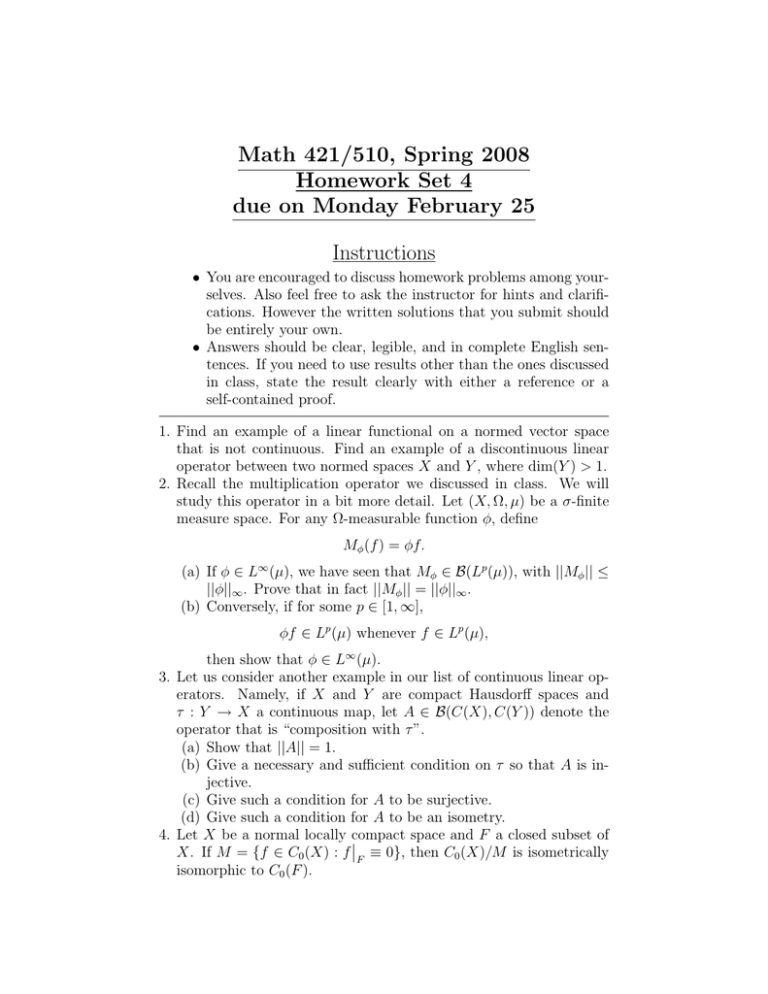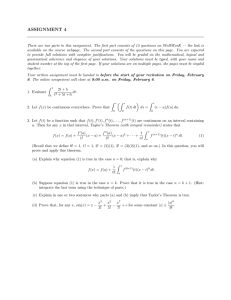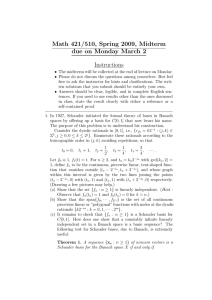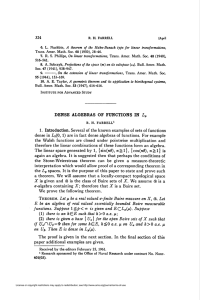Math 421/510, Spring 2008 Homework Set 4 due on Monday February 25 Instructions
advertisement

Math 421/510, Spring 2008
Homework Set 4
due on Monday February 25
Instructions
• You are encouraged to discuss homework problems among yourselves. Also feel free to ask the instructor for hints and clarifications. However the written solutions that you submit should
be entirely your own.
• Answers should be clear, legible, and in complete English sentences. If you need to use results other than the ones discussed
in class, state the result clearly with either a reference or a
self-contained proof.
1. Find an example of a linear functional on a normed vector space
that is not continuous. Find an example of a discontinuous linear
operator between two normed spaces X and Y , where dim(Y ) > 1.
2. Recall the multiplication operator we discussed in class. We will
study this operator in a bit more detail. Let (X, Ω, µ) be a σ-finite
measure space. For any Ω-measurable function φ, define
Mφ (f ) = φf.
(a) If φ ∈ L∞ (µ), we have seen that Mφ ∈ B(Lp (µ)), with ||Mφ || ≤
||φ||∞ . Prove that in fact ||Mφ || = ||φ||∞ .
(b) Conversely, if for some p ∈ [1, ∞],
φf ∈ Lp (µ) whenever f ∈ Lp (µ),
then show that φ ∈ L∞ (µ).
3. Let us consider another example in our list of continuous linear operators. Namely, if X and Y are compact Hausdorff spaces and
τ : Y → X a continuous map, let A ∈ B(C(X), C(Y )) denote the
operator that is “composition with τ ”.
(a) Show that ||A|| = 1.
(b) Give a necessary and sufficient condition on τ so that A is injective.
(c) Give such a condition for A to be surjective.
(d) Give such a condition for A to be an isometry.
4. Let X be a normal locally compact
space and F a closed subset of
X. If M = {f ∈ C0 (X) : f F ≡ 0}, then C0 (X)/M is isometrically
isomorphic to C0 (F ).
2
5. Let T : X → U and S : U → W be linear operators on normed
spaces. If X, U and W are vector spaces of finite and equal dimension, and ST is invertible, prove that S and T are both invertible.
Give an example to show that the result is false if at least one of the
vector spaces is infinite-dimensional.
6. We used the Baire Category Theorem in class to deduce that any
Hamel basis of an infinite-dimensional vector space must be uncountable. We will sketch a proof of the theorem in this exercise.
Theorem 1 (Baire Category Theorem). A complete metric space is
of the second category.
S∞ That is, if M is a complete metric space and
if we write M = n=1 En , then the closure of some En contains an
open ball.TEquivalently, if {Gn }Tis a sequence of dense, open sets in
∞
M , then ∞
n=1 Gn 6= ∅; in fact,
n=1 Gn is dense in M .
(a) Prove that any complete metric space satisfies the “nested set
property”, namely if F1 ⊃ F2 ⊃ F3 ⊃ · · · is a decreasing sequence
of nonempty closed sets in M with diam(Fn ) → 0, then
T∞
F
n=1 n 6= ∅, and consists exactly of one point. Incidentally,
the nested set property is equivalent to completeness, though
you will probably not need the converse statement for this problem.
(b) Prove the Baire Category Theorem. (Hint: Start with a collection {Gn } of dense open sets in M . Fix any x0 ∈ M
T and any
open ball B0 containing x0 . You should prove that ∞
n=1 Gn ∩
B0 6= ∅ (why?). Using the properties of G1 , find an open ball B1
of diameter no more than 1 such that B̄1 ⊂ B0 ∩ G1 . Repeat the
same argument to find an open ball B2 with diam(B2 ) ≤ 21 such
that B̄2 ⊂ B1 ∩ G2 . Iterate the process, and apply the nested
set property on the B̄j -s.)
7. We stated in class that C[0, 1] has a Schauder basis. The goal of this
exercise is to find one. Enumerate the dyadic rationals (i.e. rationals
of the form 2km , where k, m are non-negative integers, and k is odd)
in the usual way, as follows :
1
1
3
t0 = 0, t1 = 1, t2 = , t3 = , t4 = , · · · .
2
4
4
Set f0 ≡ 1, f1 (x) = x. If tn = kn /2mn for mn ≥ 1, and gcd(kn , 2) =
1, define the function fn : [0, 1] → R as the one that satisfies fn (0) =
fn (1) = 0, fn (tn ) = 1, fn (tn − 2−mn ) = fn (tn + 2−mn ) = 0, and fn
interpolates linearly in between.
(a) Show that the functions fn are linearly independent.
3
(b) Show that span{f0 , · · · , f2m } is the space of all continuous,
piecewise linear functions with “nodes” at the dyadic rationals
r2−m , r = 0, 1, · · · , 2m .
(c) Show that the functions {fn } have dense linear span in C[0, 1].
(d) Show that {fn } is a Schauder basis for C[0, 1].
(e) Given f ∈ C[0, 1],
Pngive a geometric description of its Schauder
approximations k=1 ak fk .
Remark : We proved in class that the collection of monomials is
not a Schauder basis for C[0, 1]. However, C[0, 1] does admit a basis
consisting entirely of polynomials (do you find this surprising?). We
may come back to this later in the semester.
8. Show that the class of continuous functions on [0, 1] is dense in
L2 [0, 1]. Can you replace “continuous” by “infinitely smooth”? How
about [0, 1] by Rn ?







